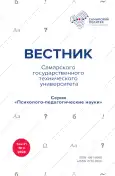Tegalnese accent and English consonant sounds: paraphrased exploration and understanding of interference
- Authors: Nabilla N.1, Prihatin Y.1, Rosdiana I.1
-
Affiliations:
- Universitas Pancasakti Tegal
- Issue: Vol 21, No 4 (2024)
- Pages: 23-36
- Section: Theory and methodology of education
- URL: https://journal-vniispk.ru/1991-8569/article/view/282546
- DOI: https://doi.org/10.17673/vsgtu-pps.2024.4.2
- ID: 282546
Cite item
Full Text
Abstract
The purpose of this research is to analyze Tegalnese accent interference in students’ pronouncing English consonant sounds, to determine the most difficult English consonant sounds for Tegalnese students to pronounce, and to identify the factors that caused strong accent in students’ pronouncing English consonant sounds. Qualitative descriptive method was used by the researchers. The participants of this research were 20 fourth-semester students majoring in the English education program at Universitas Pancasakti Tegal in the academic year 2023/2024. The pronunciation test, questionnaire and interview were used to collect the data. The pronunciation test of 24-consonant was carried out through a record player. The questionnaire on a 12-item Likert scale is based on 3 categories. While the interview was conducted through 5 open-ended questions. The results showed that Tegalnese students of English Education encountered difficulties in pronouncing 4 consonant sounds /δ, d, t, v/. Three characteristics have been identified as limiting Tegalnese students’ capacity to learn English pronunciation: exposure, motivation, and indirect communication of a high context culture. It is challenging to exclude the Tegalnese accent of «ngapak» from the pronunciation of the English consonants, and the five consonants are interfered with the Tegalnese accent, namely the consonants; /b/, /d/, /g/, /dʒ/, and /ð/. In short, Tegalnese accent continues to hinder students’ ability to appropriately pronounce English consonants. English teachers are suggested to utilize several pedagogical strategies for overcoming interference to avoid the inaccurate pronounciation.
Full Text
##article.viewOnOriginalSite##About the authors
Nahdatul Nabilla
Universitas Pancasakti Tegal
Author for correspondence.
Email: nahdlatulnabilla07@gmail.com
Bachelor Student of English Education Department
Indonesia, JI. Halmahera KM. 1 Tegal Central Java, 52121Yoga Prihatin
Universitas Pancasakti Tegal
Email: yogaprihatin@upstegal.ac.id
Ph. D. Degree, Lecturer of English Education Department
Indonesia, JI. Halmahera KM. 1 Tegal Central Java, 52121Ihda Rosdiana
Universitas Pancasakti Tegal
Email: ihdarosdiana@gmail.com
Master Degree, Lecturer of English Education Department
Indonesia, JI. Halmahera KM. 1 Tegal Central Java, 52121References
- As Sabiq A.H. Localized English for Ngapak Javanese Speakers as Language Instruction. English Franca: Academic Journal of English Language and Education. 2020. No. 4 (2). Р. 85. https://doi.org/10.29240/ef.v4i2.1818 (accessed June 23, 2023).
- Wardani N.A., Suwartono T. Javanese Language Interference in the Pronunciation of English Phonemes. Celtic: A Journal of Culture, English Language Teaching, Literature, and Linguistics. 2019. No. 6 (2). Рр. 14–25. https://doi.org/10.22219/celtic.v6i2.8589 (accessed July 22, 2023).
- Zultiyanti Z. Perbandingan Fonetik Bahasa Indonesia dan Bahasa Jawa: Sebuah Amatan Awal. Kode: Jurnal Bahasa. 2021. No. 10 (4). Рр. 40–51. https://doi.org/10.24114/kjb.v10i4.30731 (accessed July 22, 2023).
- Purwaningsih N. The Influence of Javanese Accent Toward the Students’ English Consonant Pronunciation at English Education Study Program. Jurnal Pendidikan Bahasa Inggris. 2020. No. 8 (1). Рр. 55–68. https://journal.peradaban.ac.id/index.php/jdpbi/article/view/540 (accessed Аugust 29, 2023).
- Trysnawati I., Mulyani S., Syam A. Error Analysis on English Consonant Pronunciation Produced by The Fifth Semester Students of the English Education Department. Tamaddun. 2020. No. 19 (2). Рр. 118–131. https://doi.org/10.33096/tamaddun.v19i2.77 (accessed July 22, 2023).
- Dewi R., Mujiyanto J., Sukrisno A. The Influence of Brebes Javanese Dialect Toward Students Pronunciation of English Speech Sounds (A Case Study in Sman 1 Brebes). 1st English Language and Literature International Conference (ELLiC). 2017. Рр. 189–199. https://jurnal.unimus.ac.id/index.php/ELLIC/article/view/2468/2492 (accessed Julу 24, 2023).
- Aurellia F. Javanese and English Interference in Bahasa Indonesia on YouTube. International Journal of Multilingualism. 2021. No. 7 (1). Рр. 101–115.
- Ammar M.D., Hartono R., Angraini N. English pronunciation problems analysis faced by English education students in the second semester at Indo Global Mandiri University. Global Expert: Jurnal Bahasa Dan Sastra. 2022. No. 10 (1). Рр. 1–7. http://dx.doi.org/10.36982/jge.v10i1.2166 (accessed June 23, 2023).
- Anggraini I., Bhuana G.P. The Use of Song in Learning Pronunciation. PROJECT (Professional Journal of English Education). 2022. No. 5 (2). Р. 280. https://doi.org/10.22460/project.v5i2.p280-283 (accessed June 23, 2023).
- Gao, Y. (2019). Differences and Strategies of High and Low Context Cultures from the Perspective of Burberry’s Advertisement. 309(Ismss), 317–320. https://doi.org/10.2991/ismss-19.2019.68
- Saputri, M. E., & Saraswati, G. T. (2017). High-Low Context Communication in Busisness Communication of Indonesian. Proceedings of the 3rd International Conference on Transformation in Communications 2017 (IcoTiC 2017), 150(ICoTiC 2017), 288–293. Retrieved from https://www.atlantis-press.com/proceedings/icotic-17/25902408
- Mardiyatul. (2016). Pengaruh Budaya Tinggi terhadap Pembelajaran di Sekolah Menengah Pertama. Universitas Islam Negeri Maulana Malik Ibrahim Malang. Retrieved from http://etheses.uin-malang.ac.id/6082/1/14711019.PDF
Supplementary files







